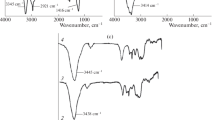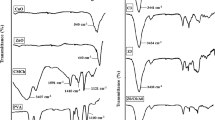Abstract
The drug delivery approach was developed through effective preparation of nanocomposite hydrogels in situ while CuO nanoparticles were being formed within swollen CMCS/starch hydrogels. Nanocomposite hydrogel have obtained significant attention in recent years as one of the most promising nanoparticulate drug delivery systems owing to their unique potentials by combining the characteristics of a hydrogel system with a nanoparticle. The obtained nanocomposite hydrogels were used as a potential candidate for controlled release of amoxicillin drug. Different experimental techniques, including XRD, EDX, and SEM were applied to study and compare the prepared hydrogels. XRD and EDX analyses confirmed the formation of nanoparticles in the hydrogel matrix, while SEM micrographs showed that CuO nanoparticles ranged from 13.89 to 47.78 nm within the same matrix, respectively. According to the results, increased number of nanoparticles resulted from increased ion concentration. At pH 1.2 and pH 7.4, the nanocomposite hydrogels were investigated in terms of the swelling behavior; in comparison with neat CMCS/starch hydrogel, they showed a pH-sensitive swelling ratio. Prolonged and more controlled drug releases were observed for CuO nanoparticle containing CMCS/starch hydrogel, which increased with the rise in CuO nanoparticle content.
Lay Summary
The objective of this study is to prepare a new, improved drug release using pH-sensitive polymers of carboxymethyl chitosan/starch with the weight ratios of 3:1, 1:1, and 1:3 containing copper oxide nanoparticles. Through in situ formation of nanoparticles in the CMCS/starch hydrogel matrix, the successful preparation of new CMCS/starch nanocomposite hydrogels was achieved. It was attempted to show how the concentration of the nanoparticles in the nanocomposite hydrogel influences the swelling behavior in buffer solutions and drug release behavior.






Similar content being viewed by others
References
Gholamali I. Facile preparation of carboxymethyl cellulose/Cu bio-nanocomposite hydrogels for controlled release of ibuprofen. Regen Eng Translat Med. 2019:1–10.
Pellá MCG, Lima-Tenório MK, Tenório-Neto ET, Guilherme MR, Muniaz EC, Rubira AF. Chitosan-based hydrogels: from preparation to biomedical applications. Carbohydr Polym. 2018;196:233–45.
Gholamali I. Stimuli-responsive polysaccharide hydrogels for biomedical applications: a review. Regen Eng Translat Med. 2019;1.
Yadollahi M, Farhoudian S, Barkhordari S, Gholamali I, Farhadnejad H, Motasadizadeh H. Facile synthesis of chitosan/ZnO bio-nanocomposite hydrogel beads as drug delivery systems. Int J Biol Macromol. 2016;82:273–8.
Ahmad S, Minhas MU, Ahmad M, Sohail M, Abdullah O, Badshah SF. Preparation and evaluation of skin wound healing chitosan-based hydrogel membranes. AAPS PharmSciTechm. 2018;19:3199–209.
Zhou Y, Zhao S, Zhang C, Liang K, Li J, Yang H, et al. Photopolymerized maleilated chitosan/thiol-terminated poly (vinyl alcohol) hydrogels as potential tissue engineering scaffolds. Carbohydr Polym. 2018;184:383–9.
Yadollahi M, Gholamali I, Namazi H, Aghazadeh M. Synthesis and characterization of antibacterial carboxymethylcellulose/CuO bio-nanocomposite hydrogels. Int J Biol Macromol. 2015;73:109–14.
Yadollahi M, Gholamali I, Namazi H, Aghazadeh M. Synthesis and characterization of antibacterial carboxymethyl cellulose/ZnO nanocomposite hydrogels. Int J Biol Macromol. 2015;74:136–41.
Khan S, Akhtar N, Minhas MU, Badshah SF. pH/thermo-dual responsive tunable in situ cross-linkable depot injectable hydrogels based on poly(N-isopropylacrylamide)/carboxymethyl chitosan with potential of controlled localized and systemic drug delivery. AAPS PharmSciTech. 2019;20:119.
Mohamed RR, Sabaa MW. Synthesis and characterization of antimicrobial crosslinked carboxymethyl chitosan nanoparticles loaded with silver. Int J Biol Macromol. 2014;69:95–9.
Upadhyaya L, Singh J, Agarwal V, Pandey AC, Verma SP, Das P, et al. Efficient water soluble nanostructured ZnO grafted O-carboxymethyl chitosan/curcumin-nanocomposite for cancer therapy. Process Biochem. 2015;50:678–88.
Wahid F, Wang HS, Lu YS, Zhong C, Chu LQ. Preparation, characterization and antibacterial applications of carboxymethyl chitosan/CuO nanocomposite hydrogels. Int J Biol Macromol. 2017;101:690–5.
Wahid F, Yin JJ, Xue DD, Xue H, Lu YS, Zhong C, et al. Synthesis and characterization of antibacterial carboxymethyl chitosan/ZnO nanocomposite hydrogels. Int J Biol Macromol. 2016;88:273–9.
Upadhyaya L, Singh J, Agarwal V, Tewari RP. Biomedical applications of carboxymethyl chitosans. Carbohydr Polym. 2013;91:452–66.
Upadhyaya L, Singh J, Agarwal V, Tewari RP. The implications of recent advances in carboxymethyl chitosan based targeted drug delivery and tissue engineering applications. J Control Release. 2014;186:54–87.
Subramanian SB, Francis AP, Devasena T. Chitosan-starch nanocomposite particles as a drug carrier for the delivery of bis-desmethoxy curcumin analog. Carbohydr Polym. 2014;114:170–8.
Namazi H, Hasani M, Yadollahi M. Antibacterial oxidized starch/ZnO nanocomposite hydrogel: synthesis and evaluation of its swelling behaviours in various pHs and salt solutions. Int J Biol Macromol. 2019;126:578–84.
Xiao C. Current advances of chemical and physical starch-based hydrogels. Starch/Stärke. 2013;65:82–8.
Schirmer M, Jekle M, Becker T. Starch gelatinization and its complexity for analysis. Starch/Stärke. 2015;67:30–41.
Zaman M, Siddique W, Waheed S, Sarfaraz RM, Mahmood A, Quresh J, et al. Hydrogels, their applications and polymers used for hydrogels: a review. Inter J Biol Pharm Al Sci. 2015;4:6581–603.
Agnihotri S, Mukherji S, Mukherji S. Antimicrobial chitosan-PVA hydrogel as a nanoreactor and immobilizing matrix for silver nanoparticles. Appl Nanosci. 2012;2:179–88.
Gaharwar AK, Peppas NA, Khademhosseini A. Nanocomposite hydrogels for biomedical applications. Biotechnol Bioeng. 2014;111(3):441–53.
Stoimenov PK, Klinger RL, Marchin GL, Klabunde K. Metal oxide nanoparticles as bactericidal agents. Langmuir. 2002;18:6679–86.
Tang ZX, Lv BF. Nanoparticles as antibacterial agent: preparation and activity. Braz J Chem Eng. 2014;31(3):591–601.
Zhao F, Yao D, Guo R, Deng L, Dong A, Zhang J. Composites of polymer hydrogels and nanoparticulate systems for biomedical and pharmaceutical applications. Nanomaterials. 2015;5:2054–130.
Yadollahi M, Farhoudian S, Namazi H. One-pot synthesis of antibacterial chitosan/silver bio-nanocomposite hydrogel beads as drug delivery systems. Int J Biol Macromol. 2015;79:37–43.
Gholamali I, Hosseini SN, Alipour E, Yadollahi M. Preparation and characterization of oxidized starch/CuO nanocomposite hydrogels applicable in a drug delivery system. Starch/Stärke. 2019;71(3–4).
Barkhordari S, Yadollahi M, Namazi H. pH sensitive nanocomposite hydrogel beads based on carboxymethyl cellulose/layered double hydroxide as drug delivery systems. J Polym Res. 2014;21(6):454.
Khorasani MT, Joorabloo A, Moghaddam A, Shamsi HR, Mansoori MZ. Incorporation of ZnO nanoparticles into heparinised polyvinyl alcohol/chitosan hydrogels for wound dressing application. Int J Biol Macromol. 2018;114:1203–15.
Chaturvedi A, Bajpai A, Bajpai J, Singh SK. Evaluation of poly (vinyl alcohol) based cryogel-zinc oxide nanocomposites for possible applications as wound dressing materials. Mater Sci Eng C. 2016;65:408–18.
Farhoudian S, Yadollahi M, Namazi H. Facile synthesis of antibacterial chitosan/CuO bio nanocomposite hydrogel beads. Int J Biol Macromol. 2016;82:837–43.
Rasoulzadehzali M, Namazi H. Facile preparation of antibacterial chitosan/graphene oxide-Ag bio-nanocomposite hydrogel beads for controlled release of doxorubicin. Int J Biol Macromol. 2018;116:54–63.
Gunasekaran S, Wang T, Chai C. Swelling of pH-sensitive chitosan-poly (vinyl alcohol) hydrogels. J Appl Polym Sci. 2006;102:4665–71.
Zare-Akbari Z, Farhadnejad H, Furughi-Nia B, Abedin S, Yadollahi M, Khorsand-Ghayeni M. pH-sensitive bionanocomposite hydrogel beads based on carboxymethyl cellulose/ZnO nanoparticle as drug carrier. Int J Biol Macromol. 2016;93:1317–27.
Moogooee M, Ramezanzadeh H, Jasoori S, Omidi Y, Davaran S. Synthesis and in vitro studies of cross-linked hydrogel nanoparticles containing amoxicillin. J Pharm Sci. 2011;100:1057–66.
Patel JK, Patel MM. Stomach specific anti-helicobacter pylori therapy: preparation and evaluation of amoxicillin-loaded chitosan mucoadhesive microspheres. Curr Drug Deliv. 2007;4:41–50.
Noshirvani N, Ghanbarzadeh B, Mokarram RR, Hashemi M, Coma V. Preparation and characterization of active emulsified films based on chitosan-carboxymethyl cellulose containing zinc oxide nanoparticles. Int J Biol Macromol. 2017;99:530–8.
Author information
Authors and Affiliations
Corresponding author
Ethics declarations
Conflict of Interest
The authors declare that they have no conflict of interest.
Additional information
Publisher’s Note
Springer Nature remains neutral with regard to jurisdictional claims in published maps and institutional affiliations.
Rights and permissions
About this article
Cite this article
Gholamali, I., Alipour, E. Carboxymethyl Chitosan/Starch/CuO Nanocomposite Hydrogels for Controlled Release of Amoxicillin. Regen. Eng. Transl. Med. 6, 398–406 (2020). https://doi.org/10.1007/s40883-020-00173-z
Received:
Revised:
Accepted:
Published:
Issue Date:
DOI: https://doi.org/10.1007/s40883-020-00173-z




